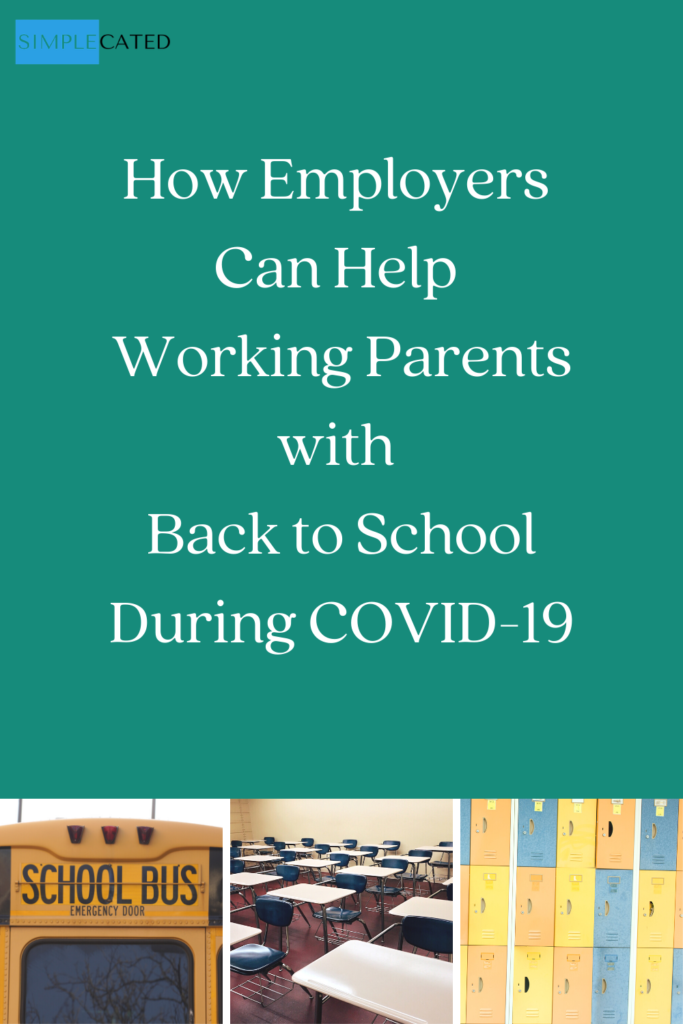With back to school quickly approaching, many working parents are beyond stressed about the fall. Due to COVID-19, some schools are beginning the year virtually while others are offering a hybrid of virtual and in-person options, all of which is leaving parents scrambling to piece together a plan for child care and education. Ayesha Badhwar is facing the challenge of figuring out how to help her 9-year old navigate his hybrid program while she works remotely all day; she’s considering taking FFCRA leave but has financial concerns about doing so since that would still lead to reduced pay. Ruzanna Yesayan and her husband are considering relocating to another state so they can be closer to family who can help with their children.
As much as working parents need child care options, they may also be anxious about sending their children in-person to school in the midst of a pandemic. An ABC News/Ipsos poll found that 55% of Americans don’t think schools should reopen. Even with these concerns, however, workers may have difficulty finding other options. The situation is particularly challenging for single-parent households. Latoya Floyd, an onsite employee at Publix, is a single parent to two elementary-aged children; she has health concerns about sending her children back to school but doesn’t have a choice.
The option to work remotely is a helpful step, although it still leaves parents struggling to juggle a full workload with monitoring their children. For many workers, however, the option to work remotely doesn’t exist. According to the Center for American Progress, Black and multiracial parents have less access to remote work, adding an additional challenge as they look for ways to provide for their families while ensuring their children are safe and learning.
Working parents have a huge need for support as they navigate the reduced back to school and child care options for the fall. The needs are particularly growing for working mothers, who tend to shoulder more of the child care responsibilities, single parents, and Black parents. Employers are anxious too. After all, you’re left trying to figure out how to retain your workers and keep business going. Where do you start?
It’s important to know what you are required to do, but I’ll tell you now – it’s not much. So, we must go beyond what’s required of us and determine what we can and should do to help and support each other through this challenging time. Our actions will demonstrate the culture of our companies.
What’s required
If you have fewer than 500 employees, then the FFCRA applies to you. For employees who have been with you at least 30 days, they can receive up to 12 weeks of leave to care for their children if the school or child care provider is closed. The first 2 weeks are unpaid (with the option to use the FFCRA’s paid sick leave benefit), and the remaining 10 weeks are paid at two-thirds the regular rate of pay up to $200 per day.
Keep in mind that many employees may have already used this benefit earlier in the year, and FFCRA leave applies if school or child care isn’t available. Another challenge is that $200 per day isn’t a lot. You can certainly pay more than that, but the tax credits won’t apply to the additional amount. Also, this only applies to those with fewer than 500 employees. If you have more, then there isn’t any paid leave federally required.
Depending on circumstances, you might need to provide regular FMLA to parents of children with serious health conditions who are unable to attend in-person school. There’s also the potential for ADA accommodation requests. The ADA only requires accommodations for employees and applicants with disabilities, however, there could be potential for an employee with a health-related disability to have concerns about increased exposure risk due to his/her child going in-person to school and make a request for an accommodation, such as working remotely so the child can do school virtually.
Going beyond
As you can see, employers will need to be willing to go beyond what’s required in order to support and retain their employees. Working parents are already exhausted due to the lack of child care options over the last few months, so they are in desperate need of assistance. Back to school is complicated enough already, so they need options that are simple – which is good news for you since I’m sure you don’t want another complicated program to run either.
With so many differing school schedules and needs of departments, parents, and children, a one-size-fits-all approach won’t cut it. Here are a variety of ideas to help your working parents navigate reduced back to school and child care options. They won’t all work for every job and every department, so consider implementing the ones that meet the needs of your particular team.
- Ask your employees what they need. You don’t have to figure this all out on your own! Ask your employees what would help, and involve them in figuring out solutions.
- Provide fully paid FFCRA leave and allow intermittent use. While you won’t get a tax credit for the additional amount you provide, you’ll be demonstrating support for your employees by not making them choose between putting food on the table and caring for their children. Allowing intermittent leave can be a great option that helps keep your business running. Employers have the option to allow FFCRA leave to be used intermittently for child care, but I see no downside to allowing it. It provides help for parents while giving you the benefit of employees continuing to work.
- Provide fully paid family leave. Many businesses aren’t covered by the FFCRA, and some parents are really uncomfortable with in-person school or child care right now even if it is available. Consider providing an amount of paid family leave above 12 weeks (since some parents may have already exhausted the allotted FFCRA leave), and have it run concurrently with FFCRA leave.
- Allow remote work whenever possible. If the job can be done remotely, allow it. You can still manage performance and keep the business on track. This is a great benefit to provide to all of your employees so you can make sure you’re not over-burdening those who aren’t caring for children.
- Allow flexible hours. With some jobs, it really doesn’t matter when the work is done. As long as it’s completed timely, everything is good. Rather than requiring a 9-5 schedule, allow employees to schedule their work hours around other needs and responsibilities. Employees can personalize their schedules however they need that also accomplishes business objectives. For instance, this could look like “windowed work,” where employees break up their workday into multiple, smaller time blocks, or employees might choose to just shift their workday earlier or later. One nice thing about this benefit is it can work for both onsite and remote jobs. A key to success is stepping up communication and transparency. Have employees post their schedules or designate themselves as “available” online so everyone knows when they’re working and when they’re not available. If there are certain time frames in which you need everyone working, you can designate those. And when you have a team meeting, start and end on time.
- Allow shift flexibility. Particularly with some nonexempt jobs, you need a certain number of people working each shift. You need a certain number of customer service representatives taking calls or a certain number of grocery store cashiers. You need to make sure everyone gets their hours while also limiting overtime. Empower your employees to collaborate on their schedules and find adjustments that work for everyone. Steve usually works 8-5 but needs to help his son with schoolwork in the mornings. Barbara usually works 1-10 but is willing to come in earlier, so they swap shifts. Be mindful of shift differentials – you may want to either do away with them for now or provide a specific differential to everyone who participates in adjusting their schedules as a thank you to them.
- Provide childcare options. Prepare a list of child care resources for your working parents, including in-person and in-home options. If your company already provides daycare, consider asking your provider to expand their offerings to include school-aged children. Some providers, such as Bright Horizons, also offer in-home child care and have back-up care programs that help employees with child care when their regular options fall through. Child care can be very expensive, so consider subsidizing at least part of the cost.
- Invite kids to the office. Allow your employees to bring their kids to the office. Sure we aren’t used to this on a daily basis, but we’re already in the realm of “never been there before,” and I’m sure you’d rather have your employees working than on leave (or resigning). If employees don’t have their own offices where their kids can be, they can use conference rooms – we could all use fewer meetings anyway! This opens up a possibility for groups of employees to coordinate and have their kids in a room doing their schoolwork together (still following COVID-19 safety protocols). Employees maintain the responsibility for supervising them or bringing someone in to watch them.
This is completely new territory, so it’s going to take some trial and error to find what works well for your company and your employees. You don’t have to start by agreeing to do things forever. Agree to try a few options and explain that you’ll evaluate how it goes and adjust as necessary. All of your employees will be affected by these offerings in some way, so be prepared to encourage them along this journey too. Leading during uncertainty is challenging. Remind employees of your overall goal to provide a culture of trust, support, and engagement, which requires flexibility and a willingness to try new things and adjust to circumstances. By helping your working parents navigate reduced back to school and child care options, you’ll have a greater chance of retaining them long-term and accomplishing your business goals and objectives.
Photo credit: By Cathy Yeulet / Canva





